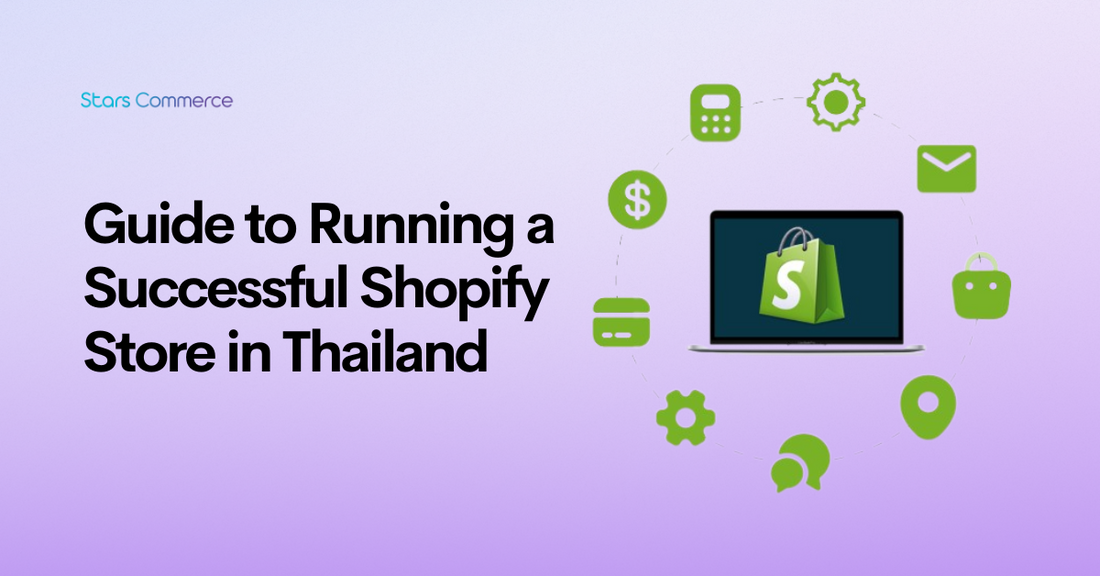The Ultimate Guide to Running a Successful Shopify Store in Thailand
Running a successful Shopify store can be a game-changer in the world of eCommerce. And if you're planning to set up shop in Thailand, you're in luck! This ultimate guide will give you all the tools and insights you need to thrive in the Thai market. From navigating the cultural nuances to understanding local consumer behavior, we've got you covered.
In this guide, we'll walk you through the different aspects of running a Shopify store in Thailand. You'll discover:
- the key steps to setting up your store,
- optimizing it for search engines,
- driving targeted traffic to your site.
- and also delve into the importance of localization, helping you tailor your products and marketing to the Thai audience.
With Thailand's booming eCommerce industry and its tech-savvy population, there has never been a better time to tap into this market. So whether you're a seasoned entrepreneur or just starting out, this guide will equip you with the knowledge to launch and grow a successful Shopify store in Thailand. Get ready to unlock your eCommerce potential in the Land of Smiles!
Understanding the e-commerce landscape in Thailand
Thailand's e-commerce landscape has witnessed tremendous growth in recent years, making it an attractive destination for online entrepreneurs. With a population of over 69 million people and a rapidly expanding middle class, there is a huge potential customer base waiting to be tapped. Additionally, Thailand boasts high internet penetration and smartphone usage, making it a prime market for online businesses.
When entering the Thai market, it's important to understand the unique characteristics of the local e-commerce landscape. The most prominent e-commerce platforms in Thailand are Lazada, Shopee, and Central. These platforms dominate the market and have a significant customer base. However, Shopify has also gained popularity among Thai entrepreneurs due to its flexibility and ease of use. By leveraging Shopify's features, you can differentiate your store and stand out from the competition.
To succeed in Thailand's e-commerce landscape, it's crucial to stay up to date with the latest trends and consumer preferences. Thai consumers have a strong preference for mobile shopping, social media influence, and convenience. By tailoring your Shopify store to cater to these preferences, you can gain a competitive edge and attract more customers.
Setting up your Shopify store in Thailand
Setting up a Shopify store in Thailand is a straightforward process. First, you'll need to create a Shopify account and choose a theme that aligns with your brand identity. Shopify offers a wide range of themes that are mobile-responsive and visually appealing. Once you've selected a theme, you can customize it to reflect your brand's personality and unique selling proposition.
Next, you'll need to configure your store settings, including your store name, address, and currency. It's important to choose the Thai Baht (THB) as your currency to facilitate seamless transactions with local customers. You'll also need to set up shipping zones and rates to ensure accurate shipping calculations for your customers.
After configuring the basic settings, you can start adding products to your Shopify store. It's important to optimize your product listings with high-quality images, detailed descriptions, and relevant keywords. This will not only make your products more appealing to customers but also improve your store's search engine visibility.
Designing a visually appealing and user-friendly Shopify store
Design plays a crucial role in the success of your Shopify store. A visually appealing and user-friendly store will not only attract more customers but also enhance their shopping experience. When designing your store, it's important to choose a clean and intuitive layout that highlights your products and makes it easy for customers to navigate.
Choose a color scheme that complements your brand and creates a cohesive look and feel. Use high-quality product images that accurately represent your products. Additionally, consider incorporating customer reviews and testimonials to build trust and credibility.
To enhance the user experience, optimize your store for mobile devices. With a significant portion of Thai consumers shopping on their smartphones, it's essential to ensure that your store is mobile-responsive and offers a seamless browsing and purchasing experience on small screens.
Optimizing your Shopify store for SEO
Search engine optimization (SEO) is crucial for driving organic traffic to your Shopify store. By optimizing your store for relevant keywords, you can improve your search engine rankings and attract more potential customers. When optimizing your Shopify store for SEO in Thailand, here are some key strategies to consider.
First, conduct keyword research to identify the most relevant and high-volume keywords in your niche. Use these keywords strategically in your product titles, descriptions, and meta tags. Additionally, optimize your URLs, image alt texts, and headings to make them more search engine friendly.
It's also important to optimize your store's loading speed, as this is a ranking factor for search engines. Compress images, minify code, and leverage caching techniques to improve your store's performance.
Furthermore, consider creating engaging and informative content related to your products or industry. This can be in the form of blog posts, guides, or tutorials. By providing valuable content, you can attract more visitors to your store and establish yourself as an authority in your niche.
Integrating payment gateways and managing transactions in Thailand
Choosing the right payment gateways and managing transactions effectively are crucial aspects of running a Shopify store in Thailand. Thai consumers have a preference for local payment methods such as PromptPay, Rabbit LINE Pay, and TrueMoney Wallet. By integrating these payment gateways into your Shopify store, you can offer a seamless and convenient payment experience for your customers.
It's also important to consider security measures to protect your customers' payment information. Ensure that your store is SSL certified and implement fraud prevention measures to build trust and credibility.
Managing transactions in Thailand requires attention to detail and compliance with local regulations. Familiarize yourself with Thailand's tax laws and ensure that you collect and remit the appropriate taxes. Additionally, provide clear and transparent refund and return policies to instill confidence in your customers.
Marketing your Shopify store in Thailand
Marketing is essential for driving targeted traffic to your Shopify store and increasing sales. In Thailand, social media platforms such as Facebook, Instagram, and LINE are highly popular and influential. By leveraging these platforms, you can reach a wide audience and engage with potential customers.
Create compelling social media content that showcases your products and encourages interaction. Consider running targeted ads to reach specific demographics or retargeting ads to reach customers who have previously shown interest in your products.
In addition to social media marketing, consider implementing search engine marketing (SEM) strategies to boost your store's visibility. Google Ads can be an effective way to target relevant keywords and drive traffic to your store. Additionally, consider collaborating with influencers or bloggers in your niche to reach a larger audience and build brand awareness.
Fulfillment and shipping strategies for Shopify stores in Thailand
Efficient fulfillment and shipping strategies are crucial for delivering a positive customer experience and maintaining customer satisfaction. In Thailand, you have several options for fulfillment and shipping, including self-fulfillment, third-party logistics (3PL) providers, and dropshipping.
If you choose self-fulfillment, make sure to optimize your inventory management and order processing to minimize errors and delays. Consider partnering with reliable courier services to ensure timely and secure deliveries.
Alternatively, you can opt for third-party logistics providers that specialize in e-commerce fulfillment. These providers can handle warehousing, packing, and shipping, allowing you to focus on other aspects of your business.
Dropshipping is another popular option for Shopify stores in Thailand. With dropshipping, you don't need to hold inventory or manage the shipping process. Instead, your supplier ships the products directly to the customer on your behalf. This can be a convenient and cost-effective option, especially for new entrepreneurs.
Managing customer support and building customer relationships in Thailand
Providing excellent customer support is essential for building trust, loyalty, and repeat business. In Thailand, customer service is highly valued, and customers expect prompt and helpful assistance.
Ensure that you offer multiple channels for customer support, such as email, live chat, and social media messaging. Respond to customer inquiries and concerns in a timely manner, and strive to exceed their expectations. Personalize your interactions and show genuine care for your customers.
Building strong customer relationships is equally important. Consider implementing a customer loyalty program or offering exclusive discounts to repeat customers. Encourage customers to leave reviews and testimonials, as positive social proof can greatly influence others' purchasing decisions.
Conclusion and key takeaways for running a successful Shopify store in Thailand
Running a successful Shopify store in Thailand requires a deep understanding of the local market, cultural nuances, and consumer behavior. By setting up your store properly, optimizing it for SEO, leveraging effective marketing strategies, and providing excellent customer support, you can position yourself for success in this thriving market.
Remember to continually monitor and adapt to market trends and consumer preferences. Stay informed about the latest e-commerce developments and emerging technologies to stay ahead of the competition. With the right strategies and a customer-centric approach, you can unlock your eCommerce potential in the Land of Smiles.
So, whether you're a seasoned entrepreneur or just starting out, this ultimate guide has equipped you with the knowledge and tools to launch and grow a successful Shopify store in Thailand. Embrace the opportunities that Thailand's booming eCommerce industry offers and get ready to make your mark in this vibrant market.



